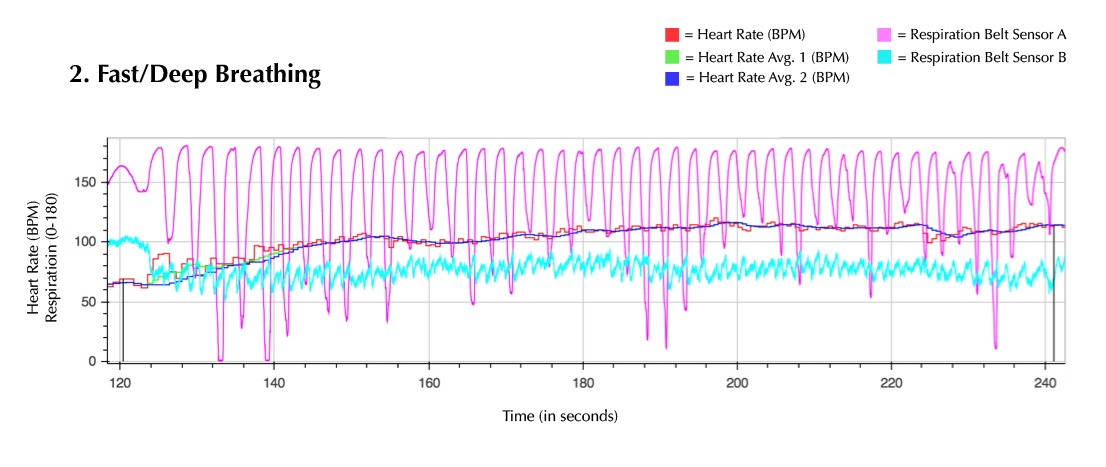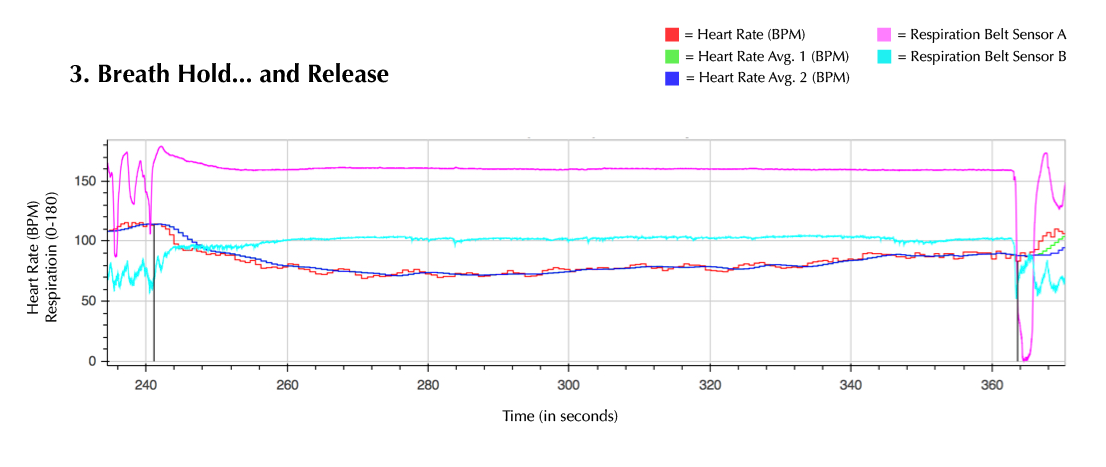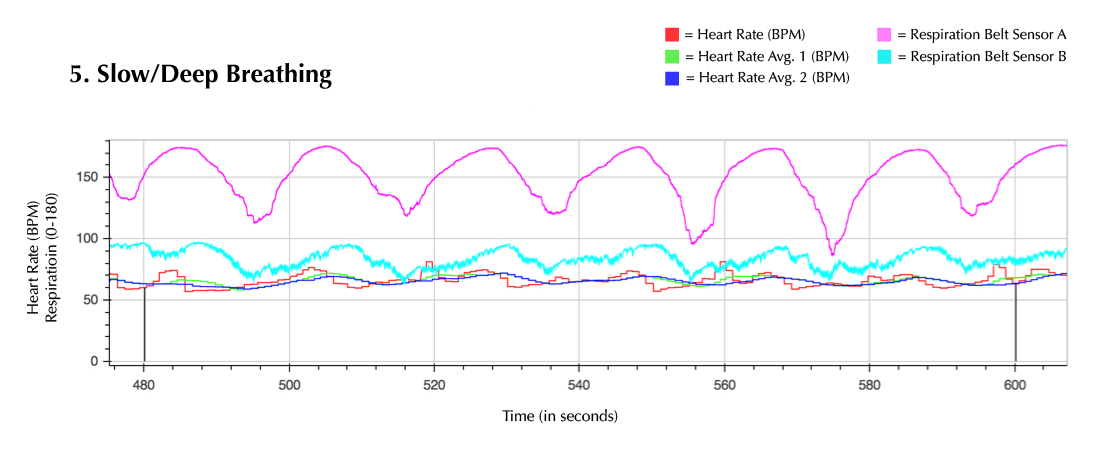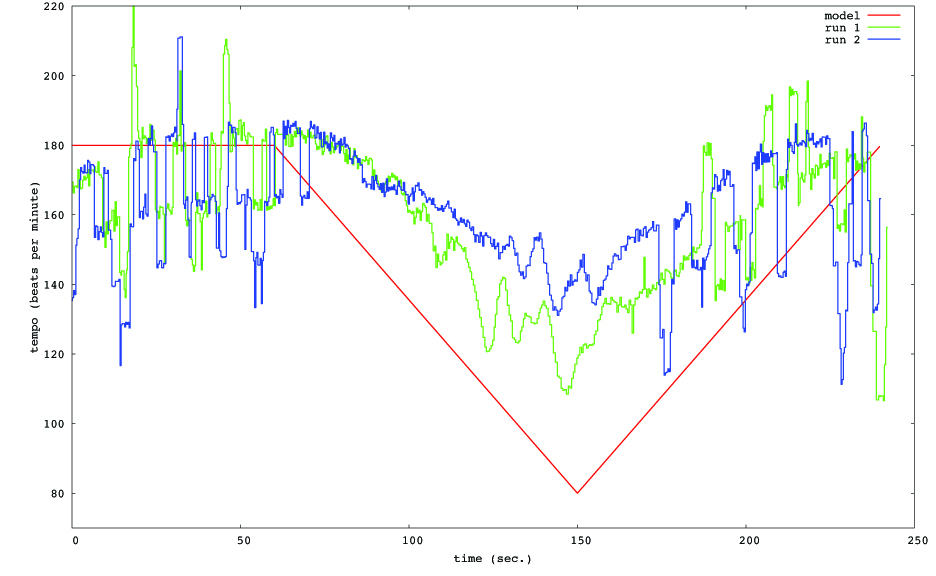On the choreography and composition of “internal” time.
Overview
Our collaboration began in 2014 with a vision to create an evening-length production for music and dance, in which heart rate data from twelve contemporary dancers is used to generate real-time click tracks for twelve corresponding musicians. In this scenario, the choreography must be designed to initiate intentional arcs in the heart activity of each dancer over time, based on a temporal pathway defined in the musical score. Each musician, click track in ear, must negotiate between the prescribed, polytemporal score, versus the actual heart rate of a dancer during the course of an event.
From September to December 2014 we moved to Paris for a full-time Musical Research Residency at the Institut de Recherche et Coordination Acoustique/Musique (IRCAM). In order to work towards our vision of an evening-length production, there were some basic questions we needed to address, most pressingly: to what extent, and by what means can dancers reproduce intentional shifts in heart rate and heart rate variability over time? During our 3 months at IRCAM, we engaged in a series of performative studies focussed on:
- Patterns of correlation between heart rate variability and respiration;
- Intentional arcs in the heart rate of dancers over time via movement improvisation; and
- Combinations of movement and breath to (re)produce shifts in heart activity (Performance Study 1).
Looking back nearly 7 years later, what has sustained our interest in the notion of reproducibility for so long is that it is essentially impossible, yet incredibly generative for us as a provocation regarding our own agency as choreographer and composer. The absurdity of relying on heart activity, which is highly autonomic and variable, as an underlying clock (in fact multiple cardiac clocks), incites ongoing negotiation between plan and action in performance. The passage of time as felt in the bodies of performers and observers, versus time as prescribed in the scores for music, movement and heart rate, versus time as realized in each performance event, engenders a layered and cacophonous iteration of what-we-call-the-choreography and what-we-call-the-composition.
But we’re getting ahead of ourselves… the early stages of our collaborative process are outlined below.
Respiration & Heart Rate
In an initial series of experiments, we examined temporal relationality of heart rate with breath, for which we used both ECG and respiration belt sensors. During sessions with two different performers, we identified reproducible patterns of variation in the heart, which relate to holding the breath, deep or shallow panting, slow inhales and exhales, and various other combinations of duration and amplitude in respiration. Importantly, we repeated the breathing structures with each dancer lying supine, sitting up, standing, walking, and eventually improvising movement, and still observed familiar patterns of relation between ECG and respiration data throughout, but with a base increase or decrease in heart rate related to the level of the dancer’s physical exertion.
Below are a series of graphs based on one session of the breathing structure outlined above, during which the performer was lying in supine position on her back. The breathing structure was also recorded with a second dancer, and many shorter tests were conducted with additional volunteers, all of which rendered consistent results.
FULL BREATHING STRUCTURE: 18 minutes
- 2 minutes “normal” breathing, as feels comfortable
- 2 minutes fast paced inhales and exhales at full amplitude (panting)
- 4 minutes to hold breath as long a possible, then release and recover
- 2 minutes slow deep inhales, long full exhales
- 3 minutes to hold breath as long a possible, then release and recover
- 2 minutes fast deep inhales, long full exhales
- 3 minutes to hold breath as long a possible, then release and recover



The slides below zoom in on each section of the breath structure, to show the patterns of correlation between respiration with heart rate and heart rate variability.
In addition to performing this breath structure while lying down on the floor, we repeated it with the following variations in behaviour:
- Sitting down cross-legged – eyes closed
- Standing, neutral – eyes open
- Walking (continuous, even pace) – eyes open
- Movement improvisations – vary eyes open and closed
- Standing, upper body gestures only
- Standing, lower body gestures only
- Full body movement, stationary
- Full body movement, travelling (all vertical)
- Full body movement, level changes
- Full body movement on floor
Regardless of these variations in body position and movement, we observed similar patterns of correlation between breath and heart activity. We also recorded respiration and ECG data from three different performers, yielding similar patterns. As such, these experimental studies served as an important basis for our thinking about how to choreograph intentional shifts in heart activity over time.
Movement Models
Intention: Observe and measure with an ECG the ability of dancers to achieve intentional arcs in heart activity during movement improvisation, based on a prescribed score.
Please Note: The ECG data in the graphs below is more noisy than in other images on the website, as these experiments were carried out very early in the research process before improvements to the software had been implemented.
Steps:
- Dancer wears ECG, and improvises movement.
- Dancer receives prompts to accelerate or decelerate heart rate, based on a prescribed score.
- ECG data is recorded to create a graph that illustrates the heart activity over time.
- ECG data from improvisation is overplayed to compare with the model score.
- Each structure is repeated multiple times to access reproducibility of results.
MOVEMENT MODEL A:
- 60 seconds: Maintain HR at 80 BPM
- 90 seconds: Raise HR from 80-180 BPM
- 90 seconds: Lower HR from 180-80 BPM
Slides:
- Original model
- Heart rate in BPM during first movement improvisation, following closely on the acceleration but descending more slowly than prescribed in the model.
- Heart rate in BPM during second movement improvisation, with similar results.
- Adjusted model to reflect the observed pattern of deceleration of heart rate of the dancer during both improvisations
MOVEMENT MODEL B:
- 60 seconds: Maintain HR at 180 BPM
- 90 seconds: Raise HR from 180-80 BPM
- 90 seconds: Lower HR from 80-180 BPM
Slides:
- Original model
- Heart rate in BPM during first movement improvisation, following closely but does not reach the low of 80 BPM.
- Heart rate in BPM during second movement improvisation, with similar results.
- Adjusted model to reflect the observed pattern of deceleration of heart rate of the dancer during both improvisations
Observations:
Movement exertion and relaxation can be an effective strategy for heart rate regulation, based on a prescribed score. The design of intentional arcs in heart activity of dancers will require further performance-based research to develop realistic models and expectations for each performer. Prescriptive scores may also be used to challenge the potential highs and lows of heart rate to extremes for each performer.
Performance Study #1
This 10-minute solo performance study draws on observations from the experiments regarding respiration and movement scores in order to compose intentional arcs the heart rate of a dancer – and therefore the musical tempo – over the course of a piece. During this solo, the dancer wears the wireless ECG unit, and her real-time heart rate data is processed to inform temporal characteristics and pitch in the electronic music.
The goals of this study include to:
- stress the potential of the ECG prototype, in terms of reliability, durability, latency, and wearability;
- evaluate the effectiveness of the beat tracking and QRS classification algorithms in the software to provide clear data during dynamic, full-bodied movement;
- choreograph an intentional and reproducible arc in the heart rate of the dancer, including patterns of heart rate variability, via breath and movement; and
- explore music as a source of biofeedback for the dancer, in terms of tempo and pitch.
The model below is the structure from which choreography and composition was developed. Although in this model the line indicating the heart rate of the danger is straight, MacCallum and Naccarato designed the score with particular attention to patterns of heart rate variability during different sections, as well as the processes of transformation between each temporal state for the dancer and music.
Below is a labelled graph that demonstrates the ECG results from one performance of the solo. The heart rate of the dancer, Teoma Naccarato, follows the score fairly closely, with expected patterns of heart rate variability based on breath and movement. Importantly, the arcs in heart rate tempo and variability from this solo have been repeated numerous times by Naccarato, as well as by a second dancer, Bekah Edie (scroll down for additional charts).
STUDY 1 – Model for Heart Rate & Breath

STUDY 1 – Model with Heart Rate Data

STUDY 1 / Dancer 1: Teoma Naccarato, Runs 1-4
STUDY 1 / Dancer 2: Bekah Edie, Runs 1-4


































